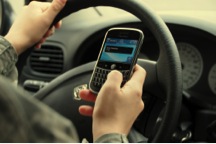
Dallas resident Bobby Jones was driving down Lovers Lane when a white Cadillac Escalade suddenly swerved over the curb and proceeded to slowly merge back into the lane as if nothing had happened.
Jones pulled up next to the driver and noticed her looking down at her lap with the bright light from her cellphone shining up on her face.
“I couldn’t believe it,” Jones said. “She was looking down the entire time and she had no regard to the fact she nearly drove across someone’s front yard.”
Texas stands as one of the last nine states that have not outlawed texting while driving.
Although it appears to be a no-brainer that texting while driving should be banned, the issue is more complicated than just making it illegal.
Laws are hard to enforce and evolving technology keep raising the ante. Those who continue to text while driving increase the risk for other drivers because they make the extra effort to discreetly hide their actions.
“People that want to text put the phone below the mirror level, so they have to look down to see it and it makes it harder to drive,” said Dennis Christiansen, the director of the Texas A&M Transportation Institute (TTI).
In a vote on April 17, the Texas Congress, including Governor Rick Perry, vetoed a bill that would ban texting
while driving.
Perry’s administration said that “texting while driving is a matter of personal responsibility.”
Christiansen said the bill and the governor’s decision left people confused by Perry’s position. TTI is a program that seeks solutions to the problems and challenges faced by all modes of transportation.
Christiansen is somewhat ambivalent to the legislation, but argues that texting while driving is largely an unenforceable law, as seen in Austin, Texas.
Austin is one of few cities in Texas that has banned texting while driving. Christiansen said that last year, Austin issued between 250,000 and 300,000 traffic tickets.
Of those violations, only a double-digit number were for texting while driving.
Regardless of the specific numbers, the ratio demonstrates how unenforceable texting while driving really is, he said.
“It requires a team of officers,” Christiansen said. “One on the side of the road scouts the drivers and then radios ahead to
another officer.”
According to a study done regarding cellphone usage by the University of North Texas, Americans sent one million texts per month in 2001, which increased to an astounding 110 million texts per month in 2009.
These shocking statistics show how dependent people have become on their cellphones. From social media to texting, Americans expect this information to be available in an instant.
The need for information raises this question: how much information can a human being consume without having their brain overloaded?
According to a study by Christine Yager of TTI, writing a text message delays one’s reaction time by 2.5 times while reading a text message delays it 1.9 times.
However, the problem stems further than just phone usage. Christiansen said the increase in automobile technology is contributing to the overload of information that drivers are receiving.
While texting and driving is its own issue, the multimedia touch screen devices installed in most modern cars are creating more distractions than ever for drivers today.
“My car is loaded with touch-screen navigation and my entire iTunes library is available at the touch of my finger,” SMU senior Mathew Rohleder said. “I find myself glancing down at the screen way more than I should be when driving.”
According to the National Highway Traffic Safety Administration (NHTSA), driving a vehicle while texting is six times more dangerous than driving while intoxicated. Imagine what that number would be if the issues associated with multimedia touch screens were added to that statistic.
For now, the problem is centered around texting while driving, which has already been banned in many states. California, for example, banned texting while driving in 2009 when Arnold Schwarzenegger was governor. Hailey Del Palacio of Los Angeles is one of the victims of the new rule change.
“I had just gotten off work and as I went to see if anyone tried contacting me, a motorcycle officer came up to the right and looked into my car and saw my cellphone in my hand,” Del Palacio said.
Del Palacio received a $161 ticket and she wasn’t even texting.
Adding to the problem is that drivers still want to access their phones, but they now have to take an extra step in hiding their phones from view while driving, ultimately making their driving more dangerous than it had been before.
Despite the controversy over making texting while driving illegal, it has been widely accepted as a problem that can only be solved, or at least temporarily helped, by banning it.
While Dallas still hasn’t conformed to this new ban, Christiansen speculates that within the next two congressional terms Texas as a state will most likely pass the bill to make texting while driving illegal.
The statewide bill would be a way to cause less confusion for drivers, but Christiansen does not think that will solve the problem entirely.
According to his agency’s research, widespread compliance will not come as a result of the legislation. Rather, the compliance will come from an educational process that can take some time.
Christiansen believes the success of limiting texting while driving comes from education and cultural changes learned over time.
“Seat belt usage increased more due to education than enforcement, and drinking and driving has become frowned upon in large part due to education,” Christiansen said.
Advertisements asking drivers to take the pledge to not text and drive are already widely used.
While these are the beginning steps to text-free driving, only time will show the outcome of this ever-growing issue.








